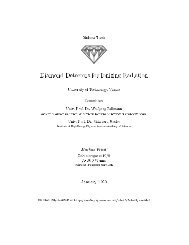You also want an ePaper? Increase the reach of your titles
YUMPU automatically turns print PDFs into web optimized ePapers that Google loves.
2 Physics at the TeV scaleThe LHC physics program aims to explore physics at energies about an order of magnitudehigher than those achieved in previous accelerators. Proton-proton collisionsat the LHC will attain a nominal center-of-mass energy of 14 TeV, compared to theprevious record of 1.96 TeV in proton-antiproton collisions at the Tevatron. The followingsections review some of the expected physics processes from Standard Modelphysics to possible new physics beyond the Standard Model.2.1 Standard Model Physics2.1.1 QCD and Jet StudiesSince the LHC is a hadron collider, it provides a very rich environment for the studyof QCD phenomena. In the dominant hard scattering mode the incoming protonsdissociate and produce at least two primary jets from the partons involved in theevent. The expected dijet invariant mass distribution 1 is well understood theoreticallyand has been measured over a wide range of energies and beam intensities at previoushadron colliders. Differences from the expected spectrum (see Fig. 2.1) would bean indicator for possible new physics beyond the Standard Model. The final resultsshould produce an improved understanding of the strong coupling α S and the partondistribution functions.2.1.2 Underlying Event StudiesThe “underlying event” consists of all parts of a hard scattering event besides thosetriggered by the primary parton interactions. Typically, a hard scattering event leadsto two high-p T jets from the scattered partons and two jets travelling roughly in thedirection of the beam (the remnants of the original hadrons). Effects from the remnantsand from multiple parton scattering influence the development of jets and need tobe corrected for when matching jet observables to hard scattering events. Differenttheoretical models exist and substantially disagree on a number of observables, such asthe total cross section, charged particle multiplicity or average p T contributions fromthe underlying event.Reference measurements are needed to distinguish between these models. The basicconcept exploits the described event topology to define a transverse region relative tothe jets from hard scattering. This should be relatively free of products from the hard1 The invariant mass of a dijet event is defined as the invariant mass of the two highest-energy jetsin the event, calculated as m = √ (E 1 + E 2) 2 − (p 1 + p 2) 2 .3












